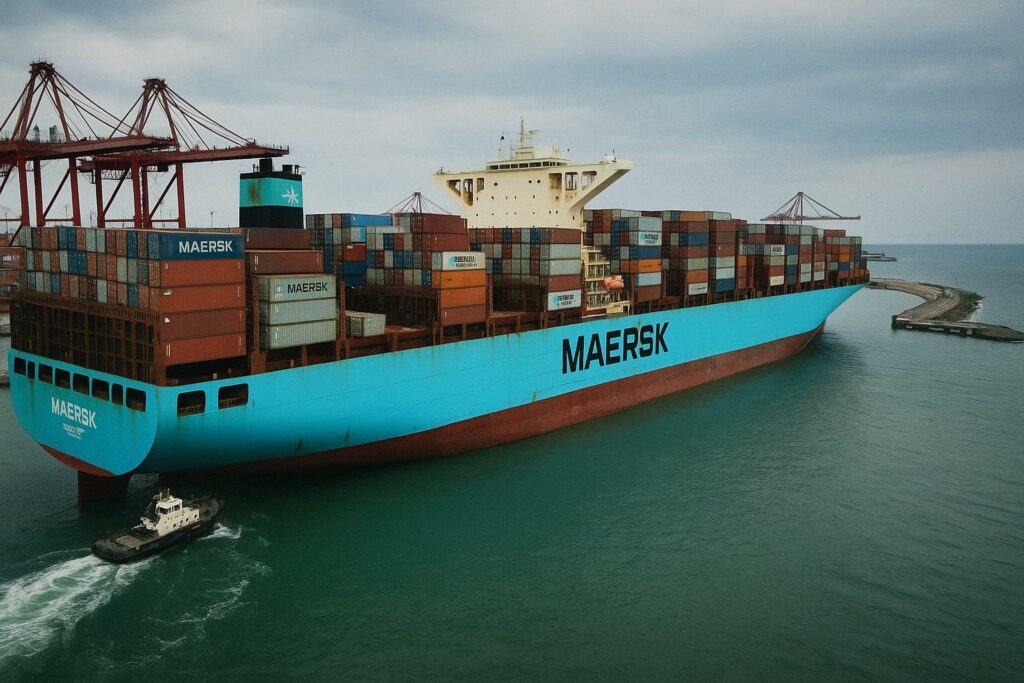Strategic Leap for Pointe-Noire Hub
A deep ocean swell and a cobalt horizon framed the entrance of the Maersk Halifax when the 368-metre vessel eased alongside the quays of Congo Terminal after a swift transit from Cape Town. Beyond the symbolism of a first call by a ship exceeding 15,000 twenty-foot equivalent units, the event provides tangible evidence that Pointe-Noire is consolidating its status as a pivotal relay between the Atlantic and the fast-growing markets of Central Africa. Port authorities report that average turnaround times have been divided by two over the past decade, a trend confirmed by regional shipping statistics.
Infrastructure Investments Since 2009
Such operational agility has not occurred overnight. Since the concession was awarded in 2009, Africa Global Logistics—through its subsidiary Congo Terminal—has channelled more than €350 million into dredging, yard reinforcement and the lengthening of berths. Modern ship-to-shore cranes with a 65-metre outreach now line the waterfront, allowing the port to handle behemoths once confined to hubs in the Gulf of Guinea. Interviews with senior engineers indicate that the most recent dredging campaign lowered the channel to 16.5 metres, comfortably aligning Pointe-Noire with international Panamax-plus standards.
Training and Technology Edge
Behind the gleaming hardware lies a workforce whose proficiency is increasingly cited by shipowners as a competitive advantage. According to Christel Anga, Execution Manager at Congo Terminal, more than 1,200 dockers, planners and maintenance technicians have undergone certified programmes in partnership with the World Maritime University since 2015. “The arrival of Maersk Halifax is a collective achievement,” she stresses, noting that remote-controlled cranes and AI-driven yard management systems now complement human know-how. Productivity metrics compiled by the terminal show peak performance of 35 moves per crane per hour during the Halifax call, in line with benchmarks at Jebel Ali or Valencia.
East Mole Expansion Outlook
Management is already looking beyond this milestone. Construction works have started on the East Mole platform, a reclaimed area designed to berth vessels of more than 20,000 TEU once operational in 2027. Civil engineers confirm that the project involves 800 metres of additional quay and an automated gate complex capable of processing 1,000 trucks a day. Environmental impact assessments approved by the Ministry of the Environment emphasise shoreline stabilisation measures and the use of low-carbon concrete, reflecting the administration’s commitment to green growth. Maritime economists predict that, once completed, Pointe-Noire could rival Lome and Abidjan in annual box volumes, potentially generating 3,000 direct jobs and multiplying fiscal revenues.
Regulatory and Economic Perspective
From a legal standpoint, the concession framework balances state sovereignty with long-term private investment. The public-private partnership clause allows the Republic of the Congo to retain ownership of strategic assets while benefiting from AGL’s expertise. Lawyers specialising in maritime law underline that transparent fee schedules and a single-window customs system have reduced transaction costs by 18 percent for exporters of timber, manganese and refined petroleum products. The policy coherence resonates with the government’s National Development Plan, which lists logistics as a catalyst for diversification away from hydrocarbons. Economists consulted suggest that each additional 1,000 TEU handled translates into CFA 7 million in value-added across the supply chain.
What to Remember
The maiden call of the Maersk Halifax is both a technical exploit and a strategic signal. It confirms that the substantial capital outlays initiated in 2009 are beginning to yield network effects, positioning Pointe-Noire as a credible alternative to congested West African hubs. Stakeholders are now turning their attention to the timely delivery of the East Mole, a litmus test for the port’s aspiration to accommodate the next generation of ultra-large container vessels.
Economic Focus
Underpinning the fanfare is a sober macroeconomic calculus. According to central bank data, logistics services already contribute 5.2 percent to Congo-Brazzaville’s GDP, up from 3.1 percent in 2010. Analysts forecast that successful scaling of port capacity could lift that share above 7 percent by 2030, aligning with continental averages and reinforcing the country’s ambition to become a sub-regional trade facilitator. For shippers, the ability to route cargoes directly rather than via transshipment hubs means lower freight premiums and greater schedule reliability—benefits that should ripple through consumer prices and industrial competitiveness alike.

